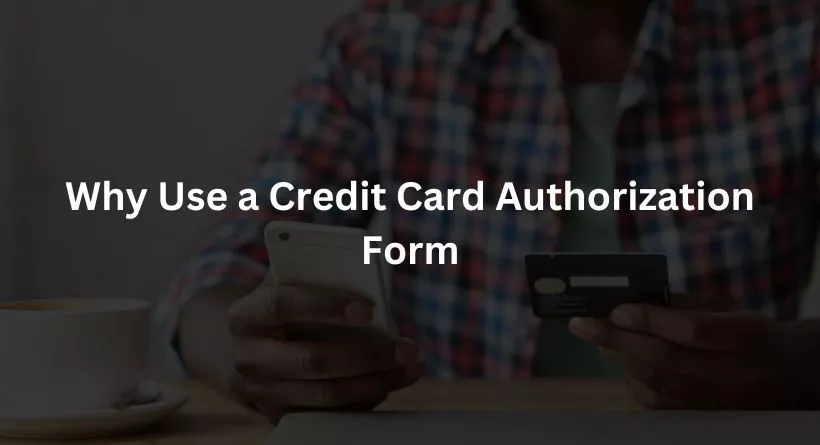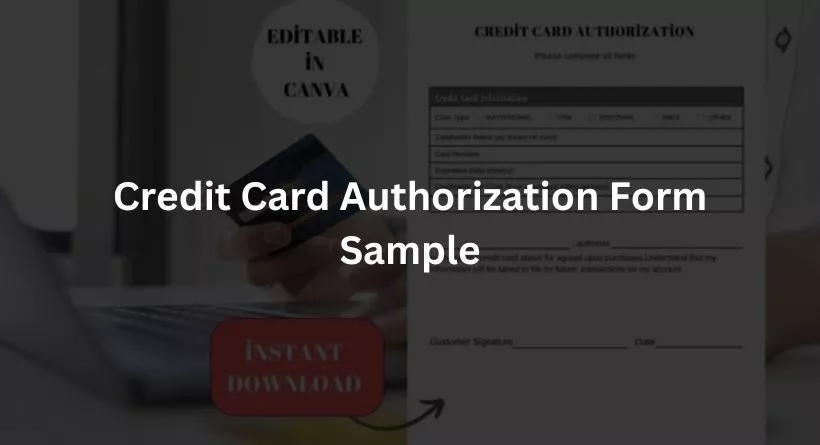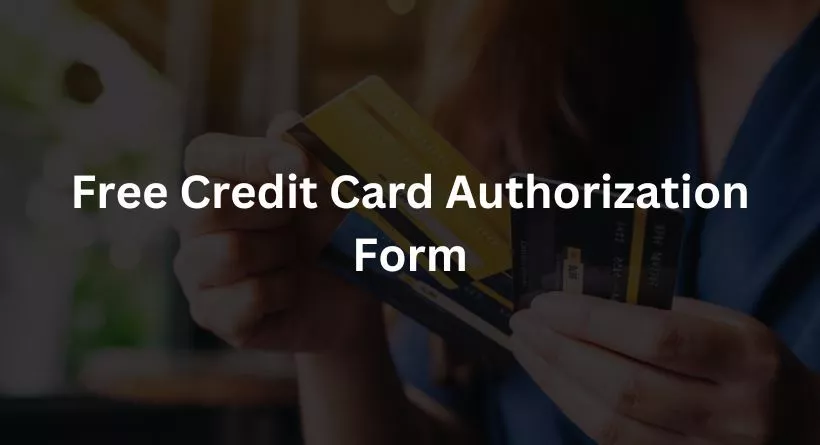There is considerable danger if you accept payment by credit card and the card isn’t present. You might request your consumer to sign a document authorizing you to routinely charge their credit card in order to protect yourself from that risk, which includes chargebacks. An authorization form for credit cards is what the paperwork is called.
What Is a Credit Card Authorization Form
An authorization form for credit cards gives a company permission to use a customer’s credit card for the duration of the form’s designated length of time. The ability to charge a cardholder repeatedly on a monthly, quarterly, or annual basis is now available to you.
This is a typical procedure when someone signs up for a service that automatically renews every so often, like paying rent or joining a gym. The company must complete the form in writing before having the cardholder sign it.
When and Why Use a Credit Card Authorization Form

As was already discussed, this type of form is employed when a company has to charge a client without a credit card being on hand. You assume some risk as a business owner when you charge a consumer in this case.
You’ll mostly be at risk from chargebacks. This is a payment that has been returned to a transaction’s payer. Consumers are meant to be protected by chargebacks from fraudulent and unauthorized purchases. In this case, the consumer will question a charge made by your company and request a refund from the card company.
Terms to Include in a Credit Card Authorization
An authorization form for a credit card is not overly difficult. In fact, using one of our online forms makes it pretty easy to fill one out at home. The following conditions must be present for the document to be legitimate:
- Cardholder information
- Credit card information
- Information about the vendor’s business
- Authorization paragraph
- Signature of cardholder
How to Accept a Payment with a Credit Card Authorization
Two distinct phases are involved in a payment card transaction. The authorization of the purchase is the first of these. This does not really transmit money to the retailer, but it does let the company know that there is money available for a transaction. The merchant subsequently makes an authorization request to the cardholder’s bank.
The account will then be settled and the payment transferred if the authorization request is granted. However, retailers also have the option to put an authorization hold on the cardholder’s account. As a result, the customer’s credit limit is decreased until the transaction is finished. This often lasts one to thirty days.
Do credit card authorization forms help prevent chargeback abuse?
Consumers are shielded against fraudulent purchases through chargebacks. They happen when a client challenges a charge from your company and requests that the card company reverse it.
But because disputed money are withheld from the firm until the card issuer chooses what to do, chargebacks can seriously impact enterprises. Chargebacks take a lot of time and require a lot of documentation for firms.
An authorization form for credit cards is one approach to safeguard yourself from chargebacks. Your chances of succeeding in your dispute with the card issuer are significantly higher and less difficult if you have a written document from the cardholder authorizing you to charge their card for services delivered.
Find out more about other chargeback prevention strategies for your company.
Types of Credit Card Authorization Templates
Depending on the particular industry and situation, there are a wide variety of credit card authorization templates. Discover which type is best appropriate for your circumstance by reading on.
Standard Credit Card Authorization form
The most fundamental kind of authorization form is this one. It is a generally recognized standard template that may be applied to a wide range of transactions. For the majority of credit card authorizations, it needs certain information.
One-Time Credit Card Authorization Payment Form
For payments that will only happen once, use this template. Typically, this template is shorter and simpler to complete.
Recurring Payment Credit Card Authorization
Charge recurring payments to a cardholder using this kind of credit card authorization. The form contains information on the frequency and total of each charge.
Hotel Credit Card Authorization
For visitors using a credit card belonging to a third party, a hotel credit card authorization form is required. All payments made with this card will be used to cover their hotel stay. The cardholder’s signature and consent are needed.
Airline Credit Card Authorization
An airline credit card authorization form must be filled out when purchasing a ticket through paper form. The traveler may pay for their own or another person’s ticket by signing this form and giving it to the airline.
You May Also Like Reading: How to Import from China in 7 Steps in 2023
Credit Card Authorization vs ACH Authorization Form
An automated clearing house (ACH) authorization is a payment that permits a company to debit a client’s bank account in order to collect payment. This document provides a written authorization to debit a checking or savings account. A credit card authorization, on the other hand, grants consent to charge the credit card account.
Credit Card Authorization Form Sample

It’s beneficial to see a sample credit card authorization form before creating your own. This will help you become accustomed to the final format of the document and the information that must be contained inside it.
If I’m a Square seller, when should I use an authorization form?
For recurring transactions, whether they are manually submitted card-not-present transactions or Card on File transactions, credit card authorization forms are particularly helpful. The form performs two tasks: Everyone saves a ton of time, and the chance of customers complaining that they were charged when they shouldn’t have is reduced.
Consider that every other week, your restaurant provides lunch catering for a nearby workplace. If you have an authorization form on file, you are aware that you can charge their card whenever that office requests a delivery. They don’t have to sign for the charge each time, and you don’t have to argue with them about what payment method to use.
However, recurring charging isn’t the only circumstance in which the authorization form is useful. A credit card authorization form can also be used to collect a down payment for upcoming purchases of products, services, or incidentals.
If you own a firm that rents pricey equipment, this is useful. A credit card authorization form can be used to keep a card hostage until the equipment is delivered.
Conclusion
Although it may seem superfluous, a credit card authorization form may be useful in the fight against chargebacks and fraud. This little step might be the difference between getting accepted for a merchant account or getting higher transaction rates, as well as whether a chargeback dispute is won or lost.
FAQs
What Is Card on File?
A cardholder authorizes a merchant to keep their payment information on file, which results in a card on file transaction. Additionally, this gives permission for future purchases to utilize these information.
How to Fill Out a Credit Card Authorization Form?
The online template of a credit card authorization form may be used to complete one. It has to be typed out and printed by the retailer. The cardholder must fill it out completely and sign it thereafter.
Why Use a Credit Card Authorization Form?
There are many possible uses for a credit card authorization form. The two that stand out the most are to reduce fraud and safeguard your company from chargebacks. But it also promotes trust among your client base.
If my customer’s card changes, do they need to sign another authorization form?
Yes, you are only permitted to charge the card shown on the credit card authorization form. Customers must fill out and sign a new form for you to maintain on file whenever they receive a new card or when their existing card expires.
How should I store signed forms and for how long?
All companies that process credit card data are required to “restrict physical access to cardholder data” according to PCI compliance rules. Store completed forms in a secure area or filing cabinet, and only allow staff who need access to do their jobs to have access. This will help keep cardholder data secure. We advise keeping any permission forms that have been signed for up to two to three months after you cease charging the card on file because chargeback timeframes might differ.

